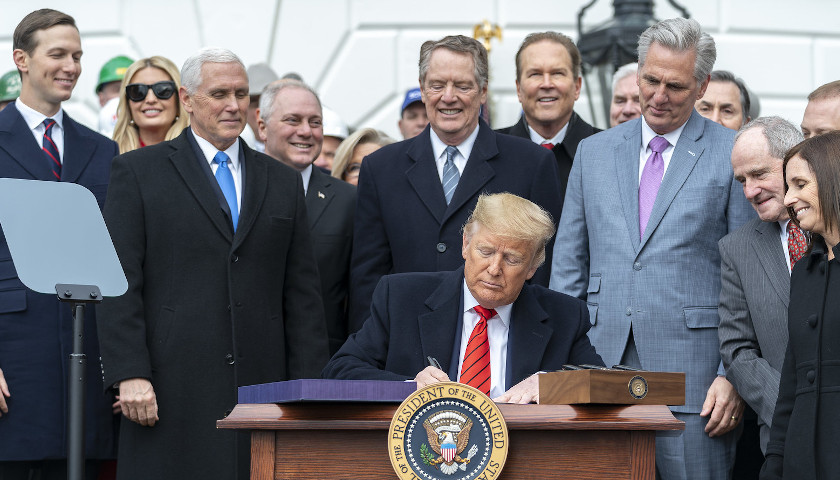by Robert Romano
The experts said it couldn’t be done, but here we are.
President Donald Trump has signed the implementing legislation for the U.S.-Mexico-Canada Agreement (USMCA) into law, and it’s a done deal, keeping the promise to replace the almost 30-year-old North American Free Trade Agreement (NAFTA).
Calling the trade deal “a colossal victory for our farmers, ranchers, energy workers, factory workers and American workers in all 50 states,” President Trump hailed the USMCA as “the largest, fairest, most balanced and modern trade agreement ever achieved. There’s never been anything like it.”
Trump ripped NAFTA in his speech, adding, “we have replaced a disastrous trade deal that rewarded outsourcing with a truly fair and reciprocal trade deal that will keep jobs, wealth, and growth right here in America.”
To get it across the finish line, President Trump had threatened to leave NAFTA altogether. On Dec. 1, 2018, Trump told reporters, “I’ll be terminating it within a relatively short period of time. We get rid of NAFTA. It’s been a disaster for the United States… And so Congress will have a choice of the USMCA or pre-NAFTA, which worked very well.”
The pressure worked as Canada and Mexico were brought to the table, and ultimately, delivered overwhelming majorities in the House and the Senate on final passage.
Since 1994, when NAFTA went into effect, the U.S. has had more than $1 trillion of goods trade deficits with Mexico and in excess of $930 billion with Canada, which are directly subtracted from the Gross Domestic Product.
Combined with the lack of any trade deal with China let alone a fair and reciprocal one — that is, until Trump came to town — in 2016, Trump was able to effectively highlight outsourcing as a key economic concern with union and conservative households in the Rust Belt states of Pennsylvania, Ohio and Michigan that put the President over the top in the Electoral College.
Now, in 2020, the President will be able to cite his art of the deal as everything he promised, using U.S. leverage to gain new trade deals with Canada, Mexico, China, Japan and South Korea that are now in the bag.
And with the USMCA, Trump can say these are better deals that would have never been renegotiated had he never been elected.
Country of origin requirements are being increased to 75 percent, up from 62.5 percent, requiring automobiles will have at least three-quarters of their parts made in North America.
On intellectual property, copyrights, trademarks and patents will have powerful enforcement provisions to end theft of U.S. intellectual property.
On financial services, U.S. financial services will be allowed to compete in Canada and Mexico with most-favored nation treatment.
On textiles, the agreement will “[p]romote greater use of Made-in-the-USA fibers, yarns, and fabrics by: [l]imiting rules that allow for some use of non-NAFTA inputs in textile and apparel trade… [and by] [r]equiring that sewing thread, pocketing fabric, narrow elastic bands, and coated fabric, when incorporated in most apparel and other finished products, be made in the region for those finished products to qualify for trade benefits,” according to the U.S. Trade Representative.
Mexico now recognizes the right of collective bargaining and all parties agreed that “40-45 percent of auto content be made by workers earning at least $16 per hour,” according to the U.S. Trade Representative. In 2016, average pay in Mexico for manufacturing was $3.91 an hour.
On agriculture, Canada is now providing in greater access for U.S. dairy products.
On currency, per the U.S. Trade Representative, the USMCA “address[es] unfair currency practices by requiring high-standard commitments to refrain from competitive devaluations and targeting exchange rates, while significantly increasing transparency and providing mechanisms for accountability.”
This provision for currency in the trade deal has now set the template for other trade negotiations, enabling the Trump trade team to get similar currency concessions in the phase one U.S.-China trade deal. As it turns out, China is not the only economy to manipulate currency. Since 2008, the Mexican peso has depreciated against the U.S. dollar by about 50 percent, from $0.10 per $1 USD to about $0.05 per $1 USD. Now, under USMCA, producers can cite currency devaluation as an unfair trade practice.
Americans for Limited Government President Rick Manning praised the signing of the USMCA, saying, “The USMCA is the beginning stages of bringing the Trump trade agenda around the world and will result in more U.S. manufacturing jobs, higher standards of living and increased overall economic growth. Trump’s trade wins are among his signature accomplishments in his first term, and deliver on the promise of fair and reciprocal trade.”
Manning added, “USMCA puts America on the course to allowing American businesses and companies to compete on a level playing field, and when Americans can compete fairly, Americans win.”
And with the dogmatic intelligentsia in Washington, D.C., if President Trump had never been elected, nobody would have even tried to renegotiate these deals. If nothing else, Trump has proven that in trade relations, the U.S. has lots of leverage, and when properly utilized, can result in big wins for the U.S. economy and the American people. It’s about time.
– – –
Robert Romano is the Vice President of Public Policy at Americans for Limited Government.




